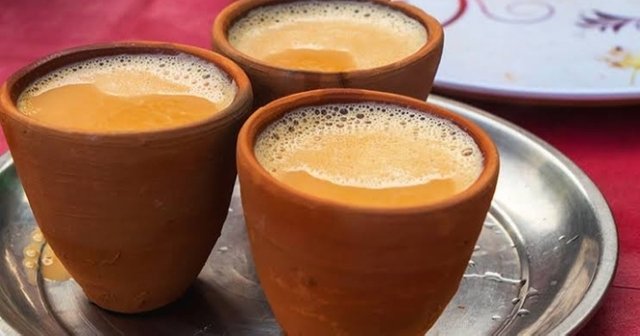The Cup Of Life ❤️
🌹Tea- 🌹
Tea is an aromatic beverage commonly prepared by pouring hot or boiling water over cured or fresh leaves of the Camellia sinensis, an evergreen shrub native to East Asia. After water, it is the most widely consumed drink in the world.There are many different types of tea; some, like Darjeeling and Chinese greens, have a cooling, slightly bitter, and astringent flavour while others have vastly different profiles that include sweet, nutty, floral, or grassy notes. Tea has a stimulating effect in humans primarily by its caffeine content.
 Tea❤️
Tea❤️
🌹-:History of Indian Tea:-🌹
The credit for creating India's vast tea empire goes to the British, who discovered tea in India and cultivated and consumed it in enormous quantities between the early 1800s and India's independence from Great Britain in 1947.
Around 1774, Warren Hastings sent a selection of China seeds to George Bogle, the then British emissary in Bhutan, for planting. But nothing seems to have come of this experiment. In 1776, Sir Joseph Banks, the great English botanist, was asked to prepare a series of notes - and it was his recommendation that tea cultivation be undertaken in India.
In 1780. Robert Kyd experimented with tea cultivation in India with seeds from a consignment stated to have arrived from China. A few decades later. Robert Bruce discovered tea plants growing wild in the Upper Brahmaputra Valley. In May 1823. the first Indian tea from Assam was sent to England for public sale.
Ironically, the native plants flourished, while the Chinese seedlings struggled to survive in the intense Assam heat and it was eventually decided to make subsequent plantings with seedlings from the native tea bush. The first twelve chests of manufactured tea to be made from indigenous Assam leaf were shipped to London in 1838 and were sold at the London auctions. This paved the way for the formation of the 'Bengal Tea Association' in Calcutta and a first joint stock Tea Company, the 'Assam Company' in London. On witnessing its success, other companies were formed to take up the cultivation of tea. Some of the other pioneer companies include George Williamson and the Jorehaut Tea Company
Having established a successful industry in Assam's Brahmaputra valley, the feasibility' of growing tea in the entire range of foot hills of the Himalayas and other parts of India was explored. By 1863, 78 plantations were established in Kumaon, Dehra Dun, Garhwal, Kangra Valley and Kulu. After the transfer of the present Darjeeling district to the East India Company in 1835 and initial trials in the 1840s, commercial plantations were started in Darjeeling in the 1850s and by 1874,113 gardens covering 18,888 acres of tea were opened and production touched 3.9 million pounds. In order to surmount the problems the industry was facing labour and law and order issues, communication, the need to expand markets and the packaging of tea the Indian Tea Association was formed in 1881 and the United Planters Association of Southern India (UPASI)was formed in 1895. In 1853. India exported 183.4 tons of tea. By 1870, that figure had increased to 6,700 tons and by 1885, it was 35,274 tons. Today, India is one of the world's largest producers of tea with 13,000 gardens and a workforce of more than 2 million people involved in its production.
🌹-:How to say tea in different languages:-🌹
-Afrikaans: tee
-Albanian: caj (pronounced chai)
-Arabic: chai or shai
-Armenian: te
-Azerbaijani: caj (pronounced chai)
-Basque: tea
-Belarusian: harbatu
-Bengali/Bangla: cha
-Bulgarian: chai
-Catalan: té
-Chinese (Cantonese): cha
-Chinese (Mandarin): cha (second tone / pronounced with the "a" in a rising tone)
-Croatian: caj (pronounced chai)
-Czech: caj (pronounced cha-i)
-Danish: te
-Dutch: thee
-English: tea
-Esperanto: teo
-Filipino/Tagalog: tsaa
-Finnish: tee
-French: le thé (masculine)
-Galician: té
-Georgian: chai
-German: der Tee (masculine; the "T" is capitalized because all German nouns are capitalized)
-Greek: tsai
-Haitian Creole: té
-Hebrew: teh
-Hindi: chai
-Hungarian: tea (plural: teak)
-Irish: tae
-Italian: te (pronounced teh)
-Icelandic: te
-Indonesian: teh
-Japanese: o-cha (o- is used as a prefix meaning "honorable" and -cha is used to mean "tea" in various tea names, such as matcha, sencha and hojicha)
-Korean: cha
-Latvian: teja (pronounced tay-ya)
-Lithuanian: arbata
-Luxembourgish: Téi (like in German, all nouns are capitalized in Luxembourish)
-Macedonian: chaj (pronounced chai)
-Malay: teh
-Maltese: te
-Norwegian: te
-Persian: chay (pronounced chai in most areas)
-Polish: herbata
-Portuguese: cha (pronounced shah with a Brazilian accent)
-Romanian: ceai
-Russian: chai
-Serbian: caj (pronounced chai)
-Sinhalese (Sri Lanka): thé (The word for teapot is actually a Dutch loanword. It is theepot.)
-Slovakian: caj (pronounced chai)
-Slovenian: caj (pronounced chai)
-Somali: shaah
-Spanish: el té (masculine; pronounced tay)
-Swahili: chai (pronounced cha-i)
-Swedish: te
-Taiwanese: de (boba naicha refers to Taiwan; popular "tapioca pearl tea")
🌹-:Top 10 Most Selling Tea Brands In India:-🌹
~Tata Tea. Source. ...
~Taj Mahal Tea. Source. ...
~Red Label Tea. Source. ...
~Wagh Bakri. Source. ...
~Lipton. Lipton is gaining popularity as Indians are getting heralth concious and this brand is famous for its green tea. ...
~Tetley. Source. ...
~Society Tea. ...
~Pataka Premium.
💥 So tea as you Cleary can see is or somewhat important to this world. Creates connections between country's, and jobs for those country's that may don’t have enough jobs. The country's spaced out in the world has created large marketing for tea to be consumed from a large number of customers. The producers are from a broad range and can produce different types of tea, some better than others. 💙
Thank you for reading.❤️❤️
Are you a Tea lover?😃
Please comment.👍